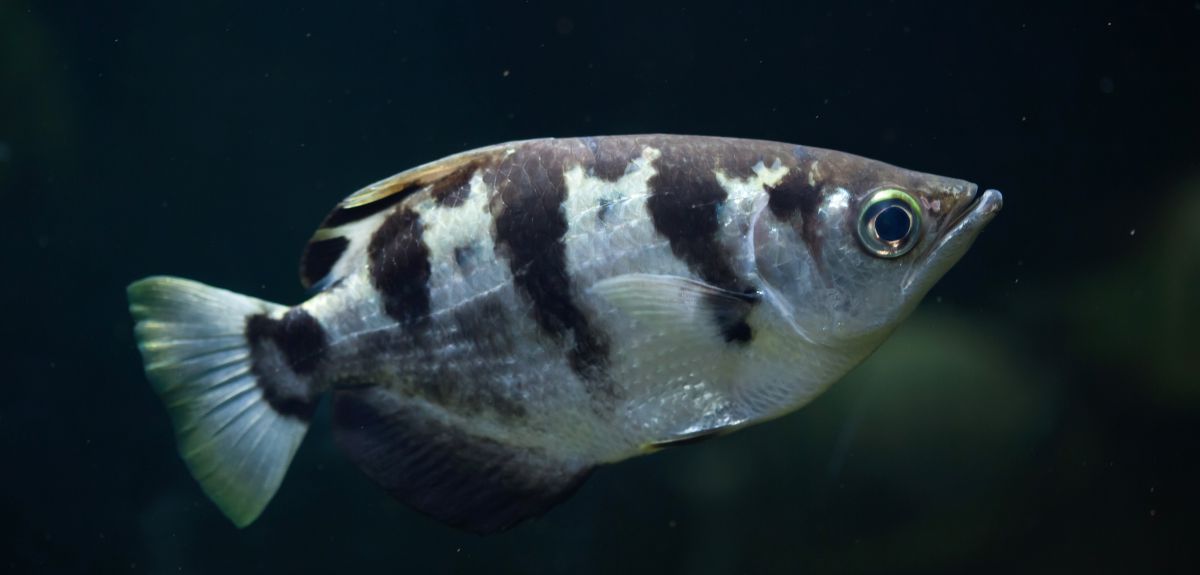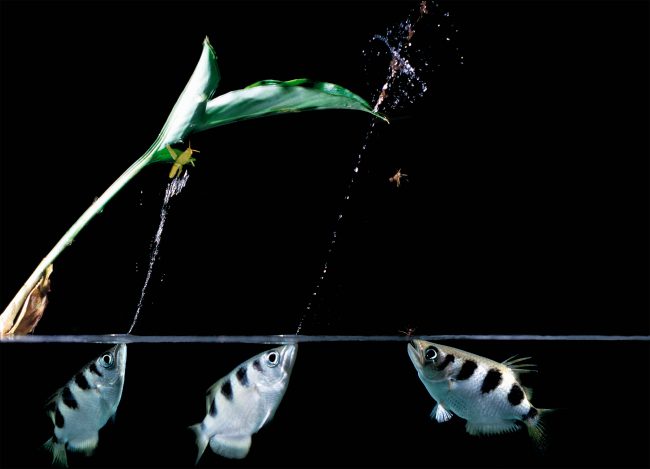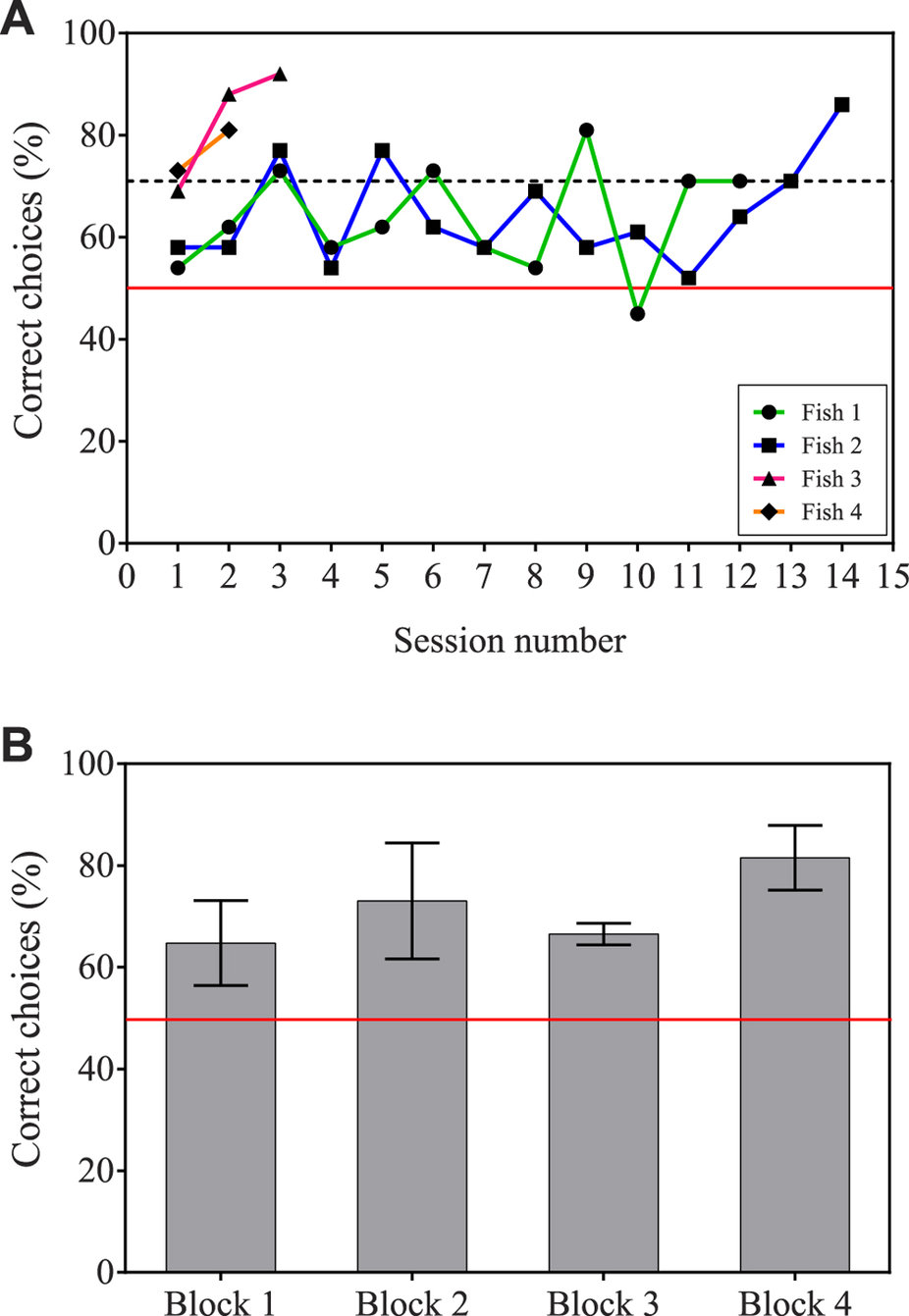Scientists from Oxford proved: fish can learn to distinguish people's faces
In an attempt to understand and appreciate the peculiarities of the process and the depth of perception of us with other living creatures around us, the scientists at Oxford University were able to teach the fish of the Taxotidae family to memorize and identify the faces of people seen before. The value of the experiment and its results are not only in the practical component, but also in the spectacle of the "staging". However, judge for yourself ...

It's funny, but the reward mechanism, which makes the fierce lions like kittens to become at the behest of the trainer's wand on his hind legs and jump through the burning rings, works for fish as well. And this allowed a group of scientists from Oxford to stage a series of experiments that shed light on the long-standing debate about the nature of the ability of the living beings around us to recognize faces.
Objectives of the experiment
')
There are two competing theories about how a person recognizes the faces of others: (a) the ability to recognize is innate, and is achieved through certain areas of the cortex of the neocortex , and (b) the ability to recognize is acquired and is formed in the process of coexistence with the object of recognition.
The task of research: to determine the ability of fish, as living beings without the neocortex, to recognize human faces. It is worth noting here that attempts to determine the role of the neocortex in the ability to recognize a person were previously made in experiments with pigeons. Despite the positive results of the experiments, an unequivocal answer to this question was not received, because, on the one hand, the existence of initial structures of the neocortex in birds was proved, on the other, it is difficult to completely exclude that for hundreds of years of living together with humans, pigeons did not develop devices that allow to recognize faces. As a “counterweight” to birds, fish that do not possess the neocortex, and who do not have the possibility of direct contact with a person over the entire period of their existence, have hardly developed any specific recognition tools over time.
During the training, the breeders (Toxotes chatareus) from the Taxotidae family not only learned to recognize human faces, but also to remove any doubts about this, they convincingly demonstrated to the participants of the experiment how well they learned the lesson learned.
They are inhabited by “wise” sprinklers from the family of ray-finned fish in the fresh waters of Australia, India, Polynesia and the Philippines. And a group of scientists from Oxford was attracted by these small fish just in their original way to get food: they were strikingly overwhelmingly striking the water above the water with a stream of water released from their mouths from a distance of 1-2 meters. Fallen grasshoppers, flies and mosquitoes become easy prey and even in “hard” times do not leave the population of these fish without food. It is not known who from the group of specialists came up with the idea to use the unique abilities of the breeders in the experiments, but the result finally confirmed the expectations.
The experiment and the results

For the experiment, a waterproof display was placed in the immediate vicinity of the aquarium on which color and black-and-white images from several human faces were successively displayed.

Experiment 1
At the first stage, one person was demonstrated (irritant, CS +) - it was him, according to the scientists' idea, that the fish should later be distinguished from several others, shown together at the next stage of the experiment. Having determined the necessary object, in accordance with the task set, the fish had to release a stream of water into it, proving that the lesson was learned. For diligence and correct determination of the right persons, the breeder each time was rewarded as a portion of appetizing food.
In the first experiment, four sprinklers and two images of human faces were used, one of which was taken to be a conditioned stimulus (CS +). As noted in the reporting publication, all without exception, fish learned to distinguish CS + within 2-14 sessions (figure below: Fish 1: 12 sessions; Fish 2: 14 sessions; Fish 3: 3 sessions; Fish 4: 2 sessions).

Experiment 2
In the second experiment, the task was complicated: in the pictures shown by the squatters, the shape of the head, the brightness of the image and the color gamut changed, while preserving the same faces. It is significant that in this case, the fish, after a short period of training, perfectly coped with the task.
In addition to the fact of learning the fish of the Taxotidae family, scientists came to a curious conclusion: the percentage of perception and memorization of the black and white picture was slightly higher (86%) than the color (81%).
Thus, using two alternative methods of choice, scientists from Oxford showed that the breeders (Toxotes chatareus) are able to learn to distinguish a specific person from a large number of alternative images (in experiment 1, 44 people), and demonstrate this ability even after changing the color gamut, shape head and image brightness (experiment 2, 18 faces). This means that non-neocortex blasters, however, have impressive recognition capabilities. In this case, the demonstrated skills were obtained by them as a result of the learning process.
Publication on Scientific Reports
Publication on the University of Oxford website
That's all, with you there was a simple service for choosing sophisticated Dronk.Ru equipment. Do not forget to subscribe to our blog , there will be many more interesting ...


It's funny, but the reward mechanism, which makes the fierce lions like kittens to become at the behest of the trainer's wand on his hind legs and jump through the burning rings, works for fish as well. And this allowed a group of scientists from Oxford to stage a series of experiments that shed light on the long-standing debate about the nature of the ability of the living beings around us to recognize faces.
Objectives of the experiment
')
There are two competing theories about how a person recognizes the faces of others: (a) the ability to recognize is innate, and is achieved through certain areas of the cortex of the neocortex , and (b) the ability to recognize is acquired and is formed in the process of coexistence with the object of recognition.
The task of research: to determine the ability of fish, as living beings without the neocortex, to recognize human faces. It is worth noting here that attempts to determine the role of the neocortex in the ability to recognize a person were previously made in experiments with pigeons. Despite the positive results of the experiments, an unequivocal answer to this question was not received, because, on the one hand, the existence of initial structures of the neocortex in birds was proved, on the other, it is difficult to completely exclude that for hundreds of years of living together with humans, pigeons did not develop devices that allow to recognize faces. As a “counterweight” to birds, fish that do not possess the neocortex, and who do not have the possibility of direct contact with a person over the entire period of their existence, have hardly developed any specific recognition tools over time.
During the training, the breeders (Toxotes chatareus) from the Taxotidae family not only learned to recognize human faces, but also to remove any doubts about this, they convincingly demonstrated to the participants of the experiment how well they learned the lesson learned.
They are inhabited by “wise” sprinklers from the family of ray-finned fish in the fresh waters of Australia, India, Polynesia and the Philippines. And a group of scientists from Oxford was attracted by these small fish just in their original way to get food: they were strikingly overwhelmingly striking the water above the water with a stream of water released from their mouths from a distance of 1-2 meters. Fallen grasshoppers, flies and mosquitoes become easy prey and even in “hard” times do not leave the population of these fish without food. It is not known who from the group of specialists came up with the idea to use the unique abilities of the breeders in the experiments, but the result finally confirmed the expectations.
The experiment and the results

For the experiment, a waterproof display was placed in the immediate vicinity of the aquarium on which color and black-and-white images from several human faces were successively displayed.

Experiment 1
At the first stage, one person was demonstrated (irritant, CS +) - it was him, according to the scientists' idea, that the fish should later be distinguished from several others, shown together at the next stage of the experiment. Having determined the necessary object, in accordance with the task set, the fish had to release a stream of water into it, proving that the lesson was learned. For diligence and correct determination of the right persons, the breeder each time was rewarded as a portion of appetizing food.
In the first experiment, four sprinklers and two images of human faces were used, one of which was taken to be a conditioned stimulus (CS +). As noted in the reporting publication, all without exception, fish learned to distinguish CS + within 2-14 sessions (figure below: Fish 1: 12 sessions; Fish 2: 14 sessions; Fish 3: 3 sessions; Fish 4: 2 sessions).

Experiment 2
In the second experiment, the task was complicated: in the pictures shown by the squatters, the shape of the head, the brightness of the image and the color gamut changed, while preserving the same faces. It is significant that in this case, the fish, after a short period of training, perfectly coped with the task.
In addition to the fact of learning the fish of the Taxotidae family, scientists came to a curious conclusion: the percentage of perception and memorization of the black and white picture was slightly higher (86%) than the color (81%).
Thus, using two alternative methods of choice, scientists from Oxford showed that the breeders (Toxotes chatareus) are able to learn to distinguish a specific person from a large number of alternative images (in experiment 1, 44 people), and demonstrate this ability even after changing the color gamut, shape head and image brightness (experiment 2, 18 faces). This means that non-neocortex blasters, however, have impressive recognition capabilities. In this case, the demonstrated skills were obtained by them as a result of the learning process.
Publication on Scientific Reports
Publication on the University of Oxford website
That's all, with you there was a simple service for choosing sophisticated Dronk.Ru equipment. Do not forget to subscribe to our blog , there will be many more interesting ...

 |  |  |
| Why do online stores give money for purchases? | Review of Xiaomi Mi Air Purifier 2 or how to clean the air of the metropolis? | Return your money - choose a cashback service for Aliexpress |
Source: https://habr.com/ru/post/369343/
All Articles